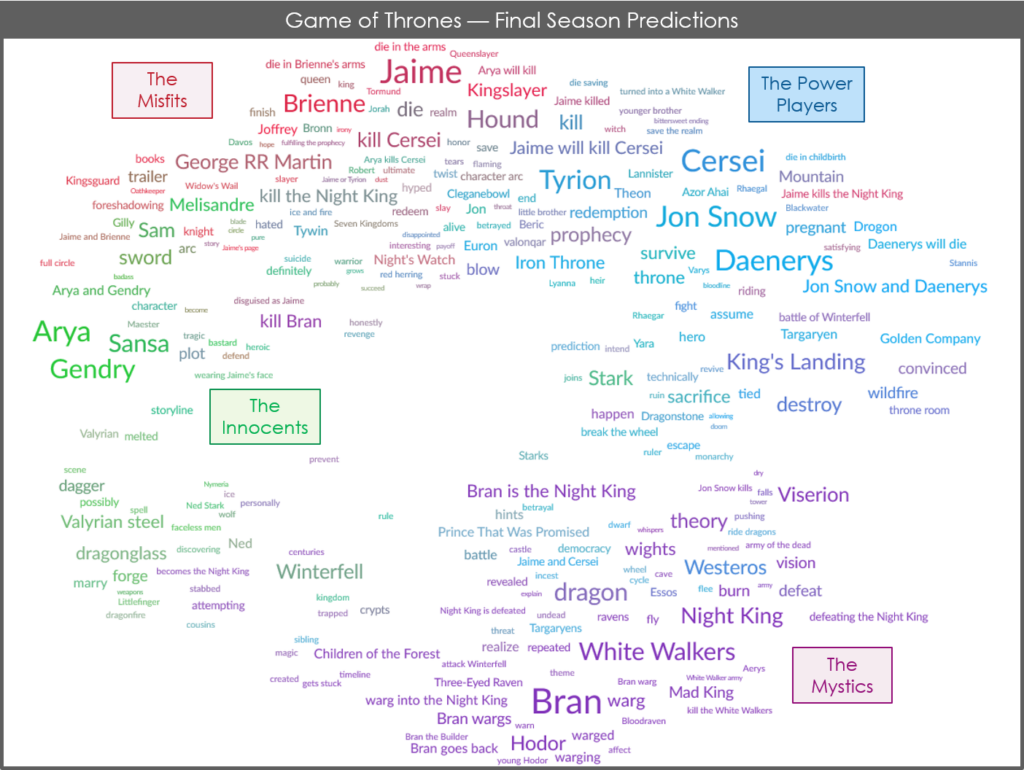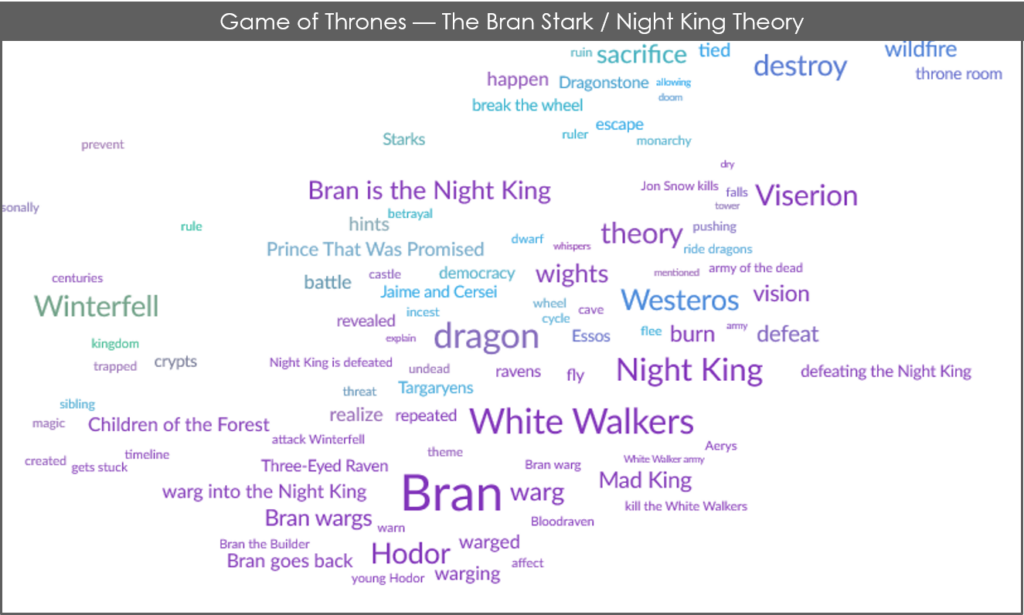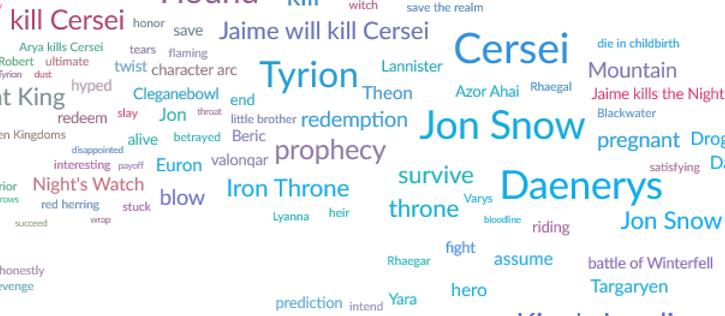A Social Media Analysis of Fan Expectations
(Note: This article may — or may not — contain spoilers for the final season of HBO’s Game of Thrones.)
With the final season of HBO’s Game of Thrones upon us, fan speculation has reached a fever pitch. How will this epic tale, 8 years in the telling, wrap up? What surprises does it have in store?
Fans have their theories — so many theories, and many of them contradictory:
- The Prince(ess) Who Was Promised is clearly Jon Snow. Or perhaps Daenerys Targaryen. Would you believe Samwell Tarly?
- Tyrion Lannister will definitely kill his sister Cersei, fulfilling Maggy the fortune teller’s prophecy. Or is Jaime destined to do it, becoming a Queenslayer? Or perhaps Arya is going to steal Jaime’s face and assassinate Cersei?
- And surely the Hound and the Mountain will finally face off in the much anticipated Cleganebowl? Or will Arya Stark be the one to bring the Mountain down?
How to make sense of all these swirling theories? Can the modern magic of machine learning identify the likeliest — or at least the most popular — outcomes for the Game of Thrones finale?
We explored this question by applying our Pathfinder Text Analytics methodology to a set of social media data taken from a recent popular Reddit thread where hundreds of Game of Thrones fans discussed their Season 8 predictions.
When 698 fan comments are analyzed by Pathfinder text analytics, the resulting text map reveals how fan expectations revolve around the series’ key characters:

Note: When reading a Pathfinder Text Analytics map, the size of a word reflects its overall importance to the data set; its proximity to other words shows the strength of the association between them; and its color reflects its connection to the map’s main themes.
So what can we learn about fan predictions from this map? Well, for starters, notice how the main characters group together:
- The Power Players: Jon Snow, Daenerys Targaryen, and Cersei and Tyrion Lannister — unsurprisingly, fans expect the ultimate struggle for the Iron Throne to play out between these characters, with one of them likely to be crowned the new ruler of Westeros when the smoke clears.
- The Misfits: Jaime Lannister and Brienne of Tarth have been Game of Thrones’ odd couple since season 2, and even though their pairing was relatively brief, they remain closely connected in fans’ minds. The strength of Brienne on the map is due in large part to her close association with Jaime, who is expected to play a key role as the series winds down, with many fans expecting him to kill Cersei (note the phrase just below his name) and, quite possibly, die in Brienne’s arms after he becomes the Queenslayer. How… romantic?
- The Innocents: The distance of Arya and Sansa Stark, Samwell Tarly, and Gendry from the ‘Power Players’ on the right side of the map indicates that these characters are expected to play a more peripheral role in the final struggle for the Iron Throne, but the size of their names suggests that they still weigh heavily on fans’ minds (or hearts). Gendry’s importance on the map may seem surprising, but is in part due to his smithing skills, which some believe will play an important role in forging dragonglass weapons to defeat the evil Night King.
- The Mystics: And speaking of the Night King, what do we make of Bran Stark standing off on his own at the bottom of the map, paired with the Night King and his army of White Walkers? Perhaps a closer look will shed some light:

By reading verbatim comments from the Reddit thread we learn that fans have some rather interesting theories about Bran Stark and his likely role. Bran’s unique placement on our text map — isolated from all the other characters — suggests that, of all the fan theories being discussed, the Bran-focused theories are generating the most intense discussion. These theories focus on Bran’s growing mystical powers and how they may prove be the key to stopping the Night King — and fans have been discussing them for years.
And it does make sense that Bran still has an important role to play. After all, George R.R. Martin must have had good reason for him to be gallivanting about north of the Wall for episode after episode. All that talk about the Three-Eyed Raven will surely lead to something important. But to what?
While the Bran/Night King theory is complex, and has fractured into a few variants, our text map suggests that it involves not only the Night King but also the White Walkers in general (will Bran go back to their original creation?), his ‘warging’ ability to enter the minds of others (be it the Night King, the Mad King, or someone else), and good old Hodor, the faithful follower who gave his own life to save Bran back in Season 6 in one of the series’ most talked about episodes.
Not that anyone expects Hodor to return from the dead, but rather that fans see Bran’s extraordinary act of warging into Hodor’s mind as a case of GRRM planting that ability for an eventual pay-off in the finale; Hodor, these fans are suggesting, didn’t die only to save Bran, but by helping Bran fully develop his warg abilities, his sacrifice will end up saving all of Westeros when Bran uses that ability again to defeat the Night King.
As one Reddit commenter noted:
“I think there’s a chance that Bran will be used as a deus ex machina element… Bran could go back in time to affect something… perhaps giving the Night King a weakness that can be exploited, or possibly keeping him from wanting to attack Winterfell.”
Or as another put it:
“Bran is clearly central to how the Night King is defeated. It has been building up for nearly the entire show.”
To sum up, while not even machine learning can reveal which, if any, of these fan theories will prove to be accurate, we can say with confidence that they are all driven by the beloved and benighted characters of Game of Thrones, and that the specific theories surrounding Bran Stark in particular seem to resonate among many of the show’s fans.
So don’t be surprised if Bran Stark, in the last episode, at the last possible moment, wargs into the Night King, or the Mad King, or a dragon, or Cersei, or someone, and saves the day.
And then dies. Of course. Because GRRM.
For more information about Pathfinder Text Analytics or this research in particular, please contact us to set up some time for us to take you through our findings and find ways we might help you learn more about your customers and how they perceive and interact with your brand and your products.










